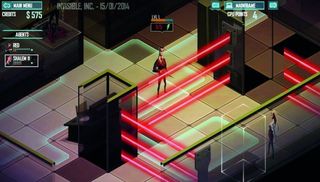Invisible, Inc: hands-on with Klei's turn-based spy thriller

Klei Entertainment's Invisible, Inc is a big, turn-based game of peek-and-go-sneak. Seriously, peering nervously around corners is a large part of this game. In fact, paranoid surveillance is all but mandatory for success. This is not a game where you brazenly swagger in, guns a-blazing. This is an environment for tactical espionage, a place where you shiftily lure patrols into janitorial closets, knock them unconscious, lock them in, walk out and install a shock trap on the door for good measure.
Not that guns aren't readily available. Even the team you begin with, the stealthoriented ACME Agency, is dressed in appropriate artillery. The problem here is that bullets are expensive. They cost action points to shoot, action points to reload. More crucially, they cost you Invisible, Inc's most precious resource: anonymity. Sometimes, all it takes to acquire your very own personal firing squad is a single, ill-timed gunshot. Similarly, virtually anything you do can potentially trigger an unwanted firefight. A misstep onto a pressure-sensitive floor panel? Being impolite to a computer geek when he finds you rooting through the mainframe? Totally legitimate ways to get yourself killed. Which is OK, because you weren't meant to be a trenchcoat-swaddled secret agent if your solution to everything is brute force. This game can and will dock cash for 'cleaning bills'.
Very much still in the alpha stage of development, Invisible, Inc is both promising and frustrating. That's partially because this complicated game of cat-and-mouse doesn't open with a tutorial. Instead, it simply dumps your two-man team in a quiet room with a computer console. No mission statement, no explanation as to what the myriad buttons peppering the interface meant. Good luck, old chap. You're on your own. HQ is watching. Tally-ho.

Much of my first two hours with the game was spent feeling slightly bewildered. At first, I tried it the old-fashioned way. I led operatives through doors and had their partners shadow them closely. It wasn't an effective technique. Guards would dogpile on them, robots would perforate their toes with bullets. It was only after a few desperate attempts that I realised I needed to peek first and select actions later. Likewise, the importance of the Mainframe mode didn't really sink in until I successfully appropriated a turret, staged a bloodied commotion in the far end of the building and snuck away while the guards were busy investigating.
Situations like that are what invite return visits to Invisible, Inc's tense, procedurally-generated levels. While currently missions are rarely more complicated than 'escape the floor' or 'shut down computer and then flee', they present opportunities to string together complex manoeuvres, and test your facility at outwitting rooms full of guards. There's also the challenge of balancing greed and pragmatism. CPU points, the currency used to hack into the game's electronic systems, don't carry from level to level. Credits do. As a result, you're forever perched on the razor's edge of a decision. Do you ransack that safe and rescue that captured agent so you can expand your two-man operation, or do you just charge to the exit?
It helps that Invisible, Inc controls easily enough. While weighted with a hundred variables to consider, the game itself operates on familiar rhythms. Your agents all come with specialised talents and unique skills. Each turn, you decide how they'll spend their action and movement points. Minor tasks like snooping around corners or opening doors will not take up precious action points but scanning for adjacent machinery will. Once you've exhausted your options, it's time to pass control to the AI. As with many turn-based games these days, navigating the interface requires only a click of the left or right mouse button. Rarely has shopping been so hazardous. We have you out, er, roboted. “I think they're dead.” “Just a minute, honey. I'm checking his wallet.” Beautiful blonde woman behind laser bars? Sounds legit.

Interestingly, Mainframe mode exists separately from this exchange of turns. So long as CPU points are available, it's entirely possible to continue hacking through electronics, forcing safes to yield their contents and cameras to defect to your purposes. But Invisible, Inc's cyberspace has its hazards. Some devices are rigged with viruses or failsafes. New programs are installed at random, making it all the more needful to ration your CPU points. Make one mistake and you might find yourself subjected to lockdown.
PC Gamer Newsletter
Sign up to get the best content of the week, and great gaming deals, as picked by the editors.
There's a lot to be excited about in Invisible, Inc. Klei Entertainment's clean, comic book art style works fabulously with the slightly campy '60s spy movie aesthetic. If you're willing to contend with a nighvertical learning curve (or dally with a community guide), it's definitely worth picking up in its current state. Already, the game is accumulating updates, the most recent of which introduced unlockable teams and a new metagame. For Klei Entertainment, a semi-indie studio already associated with reliability and cool stealth games, a bright future seems written in permanent ink.
Most Popular




